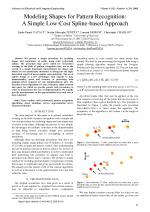| 1/2008 - 12 |
Modeling Shapes for Pattern Recognition: A Simple Low-Cost Spline-based ApproachVATAVU, R. D. |
| Extra paper information in |
| Click to see author's profile in |
| Download PDF |
Author keywords
spline, cubic polynomial, pattern recognition, algorithms, shape modeling, curves, approximation error, Haussdorff distance
References keywords
splines(5)
No common words between the references section and the paper title.
About this article
Date of Publication: 2008-04-02
Volume 8, Issue 1, Year 2008, On page(s): 67 - 71
ISSN: 1582-7445, e-ISSN: 1844-7600
Digital Object Identifier: 10.4316/AECE.2008.01012
Web of Science Accession Number: 000259903500012
SCOPUS ID: 77955605589
Abstract
We present a simple procedure for modeling shapes and trajectories of points using cubic polynomial splines. The procedure may prove useful for researchers working in the field of pattern recognition that are in the search of a simple functional representation for shapes and which are not particularly interested in diving into the hightheoretical aspects of more complex representations. The use of splines brings in a few advantages with regards to data dimensionality, speed and accuracy of processing, with minimal effort required for the implementation part. We describe several algorithms for data reduction, spline creation and query for which we provide pseudo code procedures in order to demonstrate the ease of implementation. We equally provide measurements on the approximation error and rate of data reduction. |
| References | | | Cited By «-- Click to see who has cited this paper |
| [1] J. Hershberger, J. Snoeyink, "Speeding Up the Douglas-Peucker Line-Simplification Algorithm", Proceedings of the 5th Symposium on Data Handling, pp. 134-143 , 1992.
[2] Carl De Boor, "A Practical Guide to Splines", Springer, 2001. [3] Phillip J. Barry and Ronald N. Goldman, "A recursive evaluation algorithm for a class of Catmull-Rom splines", SIGGRAPH '88: Proceedings of the 15th annual conference on Computer graphics and interactive techniques, pp. 199-204, ACM Press, New York, 1988. [4] E. Catmull, R. Rom, D. Knuth, "A class of local interpolating splines", Computer Aided Geometric Design (Eds: R. E. Barnhill and R. F. Reisenfeld), pp. 317-326, Academic Press, New York, 1974. [5] Michael Unser, "Splines and Wavelets: New Perspectives for Pattern Recognition", Pattern Recognition, pp. 244-248, LNCS 2781/2003. [6] Sambhunath Biswas, Brian C. Lovell, "Bezier and Splines in Image Processing and Machine Vision", Springer, 2008. [CrossRef] [7] Daniel P. Huttenlocher, Klara Kedem, "Computing the minimum Hausdorff distance for point sets under translation", Proceedings of the sixth annual symposium on Computational geometry, pp. 340- 349, ACM Press, 1990. [8] J.O. Wobbrock, A.D. Wilson, Y. Li, "Gestures without libraries, toolkits or training: A $1 recognizer for user interface prototypes", Proceedings of the ACM Symposium on User Interface Software and Technology (UIST '07). Newport, Rhode Island (October 7-10, 2007). New York: ACM Press, pp. 159-168. [9] Radu-Daniel Vatavu, Stefan-Gheorghe Pentiuc, Christophe Chaillou, Laurent Grisoni, Samuel Degrande, Visual Recognition of Hand Postures for Interacting with Virtual Environments, Advances in Electrical and Computer Engineering, Volume 6 (13), Number 2(26), 2006, University Stefan cel Mare" of Suceava, ISSN 1582-7445,pp. 55-58. [10] Radu-Daniel Vatavu, Stefan Gheorghe Pentiuc, Applied Hands-On Interfaces: Enhancing Object Manipulation inside Virtual Environments, European Conference on the Use of Modern Information and Communication Technologies, ECUMICT 2008, Gent, Belgium, March 13-14, 2008. [11] George Mahalu, Radu Pentiuc, Acquisition and Processing System for the Photometry Parameters of The Bright Objects, Advances in Electrical and Computer Engineering, Suceava, Romania, ISSN 1582-7445, No 1/2001, volume 1 (8), pp. 26-31 Web of Science® Citations for all references: 0 SCOPUS® Citations for all references: 0 Web of Science® Average Citations per reference: 0 SCOPUS® Average Citations per reference: 0 TCR = Total Citations for References / ACR = Average Citations per Reference We introduced in 2010 - for the first time in scientific publishing, the term "References Weight", as a quantitative indication of the quality ... Read more Citations for references updated on 2025-06-03 12:48 in 9 seconds. Note1: Web of Science® is a registered trademark of Clarivate Analytics. Note2: SCOPUS® is a registered trademark of Elsevier B.V. Disclaimer: All queries to the respective databases were made by using the DOI record of every reference (where available). Due to technical problems beyond our control, the information is not always accurate. Please use the CrossRef link to visit the respective publisher site. |
Faculty of Electrical Engineering and Computer Science
Stefan cel Mare University of Suceava, Romania
All rights reserved: Advances in Electrical and Computer Engineering is a registered trademark of the Stefan cel Mare University of Suceava. No part of this publication may be reproduced, stored in a retrieval system, photocopied, recorded or archived, without the written permission from the Editor. When authors submit their papers for publication, they agree that the copyright for their article be transferred to the Faculty of Electrical Engineering and Computer Science, Stefan cel Mare University of Suceava, Romania, if and only if the articles are accepted for publication. The copyright covers the exclusive rights to reproduce and distribute the article, including reprints and translations.
Permission for other use: The copyright owner's consent does not extend to copying for general distribution, for promotion, for creating new works, or for resale. Specific written permission must be obtained from the Editor for such copying. Direct linking to files hosted on this website is strictly prohibited.
Disclaimer: Whilst every effort is made by the publishers and editorial board to see that no inaccurate or misleading data, opinions or statements appear in this journal, they wish to make it clear that all information and opinions formulated in the articles, as well as linguistic accuracy, are the sole responsibility of the author.



